Kahina › Egyptian Obelisk » Ancient origins
Articles and Definitions › Contents
- Kahina › Who Was
- Egyptian Obelisk › Antique Origins
Ancient civilizations › Historical and archaeological sites
Kahina › Who Was
Definition and Origins
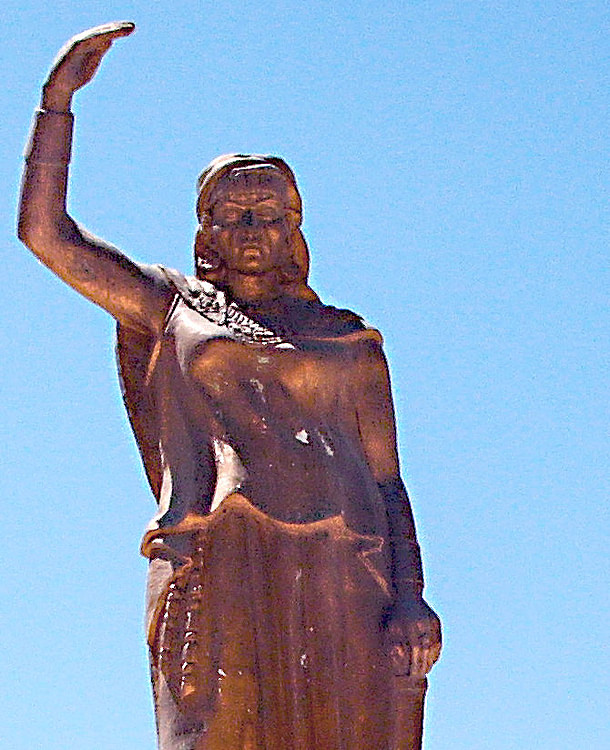
Kahina (7th century CE) was a Berber (Imazighen) warrior-queen and seer who led her people against the Arab Invasion of North Africa in the 7th century CE. She is also known as al-Kahina, Dihya al-Kahina, Dahlia, Daya, and Dahia-al-Kahina. Her birth name was Dihya, or some variant thereof (“the beautiful gazelle” in the Tamazight language of the Imazighen) while “Kahina” is an Arabic title meaning “prophetess” or “seer” or “witch”. She is said to have had supernatural powers which enabled her to foretell the future. Although she is a champion of the native North African Imazighen people, she is best known by the title given her by her Arab enemies: al-Kahina.
She was the daughter (or niece) of the Berber king Aksel (died c. 688 CE, also known as Kusaila, Caecilius, Kusiela) who was a famous freedom fighter of the Imazighen people (also known as the Amazigh, “the Free People”, the indigenous name of the Berbers ). Little is known of her life outside of her conflict with the Muslim Arab leader Hasan ibn al Nu'man (died c. 710 CE) whose Umayyad armies campaigned across North Africa.
Kahina defeated Hasan more than once and drove him from the region. Legend then claims that she engaged in a scorched earth policy to deprive the invading Muslims of any profitable goods and that this course led to a loss of support from her people. It may be, however, that the Arab armies themselves used the scorched earth tactic and later Arab writers attributed the destruction of the land to Kahina.
In her last engagement with Hasan, a significant number of her former allies fought against her. Commanding a greatly diminished force against overwhelming numbers, Kahina was defeated. She either died in battle, took poison to avoid capture, or was taken and later executed. Dates given for her death vary between 698, 702, and 705 CE, although the historical evidence suggests that the date of 698 CE is too early and her final battle was in either 702 or 705 CE.
ALTHOUGH KAHINA IS COMMONLY REFERRED TO AS A “BERBER QUEEN”, THE INDIGENOUS PEOPLE OF THE REGION KNOW HER AS AN IMAZIGHEN, WHICH IS THE MORE ACCURATE TERM.
EARLY LIFE & LEGEND
Kahina's life is only known through later Arab historians writing on the Muslim conquest of Africa. These historians, as well as other legends, claim that she was a Jewish sorceress who descended from the Beta Israel community of Ethiopian Jews. She is said to have been a royal member of the Jarawa tribe within the larger confederacy known as the Zenata Tribe of Mauretania; a princess, who then became queen and ruled over an autonomous state in the area of the Aures Mountains in modern-day northeastern Algeria.
Some sources claim that Kahina was a Christian, however, and that she derived her power from a Christian icon. At the same time, it has been argued that she practiced the indigenous religion of Numidia which included worship of the sun, moon, and veneration of one's ancestors. The claim regarding her power of prophecy is in keeping with this ancient belief in which the gods, or the spirits of the dead, could communicate with certain members of the tribe who had the gift of prophecy.
Legends suggest she could communicate with birds who were able to warn her of advancing armies. This story may have originated to explain her alleged prophetic gifts. Legends also claim she once married a tyrant who was persecuting her people and then murdered him on their wedding night.
Although she is commonly referred to as a “Berber Queen”, the indigenous people of the region know her as an Imazighen, which is the more accurate term. Scholar Ethan Malveaux comments:
The word Berber was a derivative of the Greek word Kapes Bap Bapo`owoi, which meant savage (later the English would compact it into Barbary); the Arab adopted the name for these African tribes who were once subjected by the Ancient Romans and who had (before the Muslim Conquest) wrested semi-autonomy from the Byzantine Empire. (171-172)
One of these semi-autonomous states was the kingdom of the Zenata tribe which may have once been part of larger coalitions of Imazighens in the region.
Kahina is usually described as tall and “great of hair”, which is usually interpreted to mean she wore her hair long and bunched in dreadlocks. Although later artists have depicted her as fair-skinned or even white, she was a black, African queen and would have dressed in the attire of the royalty of ancient Numidia: a loose-fitting tunic or robe worn with sandals and sometimes belted.

Masinissa
NUMIDIA & ROME
Numidia as a unified kingdom flourished between 202-40 BCE, though the history and culture of the region are much older. It is considered the first Imazighen state established in North Africa and was founded by the king Masinissa (rc 202-148 BCE) following the Second Punic War (218-202 BCE) between Rome and Carthage.
The two main tribes in the region were known as the Masaesyli, to the west, and the Massylii to the east. Although these people are commonly referred to as “tribes”, they may have been a coalition of different tribes under the leadership of respective chiefs. Masinissa united these tribes as the Kingdom of Numidia which was later divided between Mauretania and Rome following the so-called Jugurthine War (112-105 BCE) initiated by Masinissa's grandson Jugurtha (r. 118-105 BCE) against Rome.
As a province of Rome, the Imazighen became involved in the Roman Civil War between Julius Caesar and Pompey the Great in 46 BCE, and the region was subsequently controlled by Augustus Caesar (r. 27 BCE-14 CE) after 31 BCE. Numidia continued as a Roman province after the fall of the Western Roman Empire in 476 CE. It became the Praetorian Prefecture of Africa, under the Eastern Roman (Byzantine) Empire, following the defeat of the Vandals in North Africa in c. 534 CE and was then known as the Exarchate of Africa, remaining under Byzantine control.
ARAB FORCES HAD ALREADY CONQUERED MESOPOTAMIA AND EGYPT BY 647 CE, CONVERTING THE POPULACE TO ISLAM, WHEN THEY MOVED TOWARD THE MAGHREB – THE BERBER WORLD.
The Numidians under Rome became a diverse culture of religious traditions. Judaism, Christianity, and the indigenous religion of the ancient Imazighen seem to have coexisted harmoniously or, at least, there is no evidence of religious turmoil in the region during this time. As part of “Rome's bread basket”, supplying the empire with grain and its army with mercenary cavalry, the region of the Maghreb (the Berber world) prospered.
THE ARAB INVASION
In the 7th century CE, the Arabian armies began campaigns of conquest following the establishment of the new religion of Islam. While scholars today continually debate whether these campaigns could be called jihads (“holy wars”), intended to convert large populations by force, there is no doubt that was the end result.
The contention that the Arabs were not interested in forced conversion comes from certain verses of the Quran which discourage it (2:62; 2:256; 4:93; 16:125, among others) but there are other passages which support and encourage the practice (4:76; 9:5; 9:29; 9:38-39, to cite only a few). It has also been claimed that the Muslim Arabs had no motive for forced conversion because non-believers were forced to pay a tax (the jizya ) to live among Muslims and this was more profitable than forced conversion. At the same time, however, control over the resources and population of a region could prove far more profitable than a tax on unbelievers.
Arab forces had already conquered Mesopotamia and Egypt by 647 CE, converting the populace to Islam, when they moved toward the Maghreb. The Byzantine Empire was still in control of Carthage and the Maghreb at this time and the Byzantine Governor Count Gregory the Patrician mounted a defense against the invasion. Gregory was killed at the Battle of Sufetula in 647 CE, south of Carthage, and his successor paid the Arab forces a sizeable tribute to return to Egypt.

Umayyad Conquest, 7th & 8th Centuries CE
In-fighting among Arab factions prevented any further campaigns until c. 665 CE. The city of Kairouan (in modern-day Tunisia) was established as a base of Arab military operations in c. 670 CE and from there the general Uqba ibn Nafi (died 683 CE) launched his campaigns toward Mauretania in the west. The site was chosen for its relative safety from attacks by the Imazighen who had already mobilized to resist the Arabs through guerilla tactics. The resistance would soon shift their strategy to open war, however, under the leadership of Aksel of Mauretania.
AKSEL'S RESISTANCE
Aksel mounted a defense and held his kingdom against the invaders but then went on the offensive, driving them back from his borders. Aksel had been a Christian who converted to Islam voluntarily sometime earlier because it seemed more profitable. As the Arab Invasion spread and threatened his autonomy, however, he abandoned the faith and returned to the indigenous religion of the Imazighen.
Using the native religion as a rallying point, he was able to attract more recruits to his army. He was captured by the Arab forces but was allowed to live, perhaps because of his knowledge of their religion or perhaps he pretended to still be Muslim.His life was spared but he was ordered to disband his troops and convert them to Islam. Aksel agreed, was released (or escaped), and then threw his army at the Arabs, defeating Uqba ibn Nafi's forces and killing him in 683 CE.
KAHINA IS THOUGHT TO HAVE FOUGHT ALONGSIDE AKSEL IN THE 680'S CE & PROVEN HERSELF IN BATTLE.LEGENDS ASCRIBE HER THE GIFT OF PROPHECY.
Aksel capitalized on his victory by expanding his territory and gaining more recruits but was killed in battle with the Muslim Arab leader Hasan ibn al Nu'man in either 686 CE or 688 CE. At this time, he may have been succeeded by his wife (or another female relative) named Koceila who reigned as queen. If Koceila did succeed Aksel, it was not for long as Kahina was in command of the army by c. 690 CE.
REIGN OF AL-KAHINA
Kahina is thought to have fought alongside Aksel in the 680's CE and proven herself in battle. This claim is supported through the acceptance by her troops as a competent military commander. She won an early victory against Hasan (date unknown) and forced his retreat. Hasan remobilized his troops and furiously took the city of Carthage in 698 CE. Now holding the northeast regions, he again attacked Kahina and was so badly defeated that he retreated either to Libya or Egypt.
Kahina's alleged gift of prophecy is said to have enabled her to foreknow how her opponent would form troops, how they would be reinforced, and what direction they would come from. Her perceived spiritual power has led to comparisons with the French heroine Joan of Arc (1412-1431 CE) and she also shares similarities with the Native American Apache seer and female warrior Lozen (c. 1840-1889 CE) who was able to anticipate and defeat US Cavalry troops through precognition. It is said that by using her powers, Kahina may have won a third victory against Hasan, or perhaps an army under another leader while Hasan was in Egypt or Libya.
According to legend, during this engagement she was outnumbered by the Arab forces and fell back in retreat. Recognizing the direction of the wind, however, she ordered her army to set fires which the wind then carried to the enemy. The Arab army was forced to retreat and the land was so badly burned that any future campaigns would have to cross an arid wasteland without resources.
At this point in her story, there are two possible narratives. According to the Arab historians and legends, her victory by fire gave Kahina the idea to initiate a scorched-earth policy on a large scale. She is claimed to have believed that the Arabs were only interested in the riches of the land and that, if she removed these, they would leave her people alone. She therefore commanded her army to tear down the fortifications, destroy the cities and towns, and melt down the gold and silver. She further ordered orchards cut down, fields burned, and even private gardens destroyed.
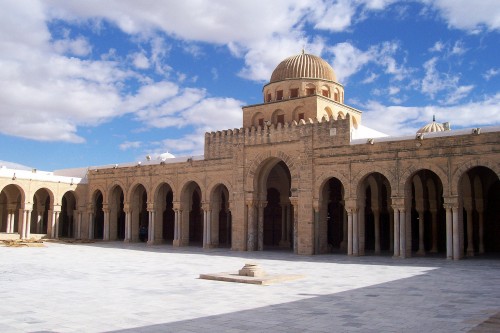
Kairouan Mosque Courtyard
She allegedly engaged in this tactic to save her people but, to those who lived in the towns and cities and relied on the fields and orchards, Kahina's policy was disastrous. Their homes and businesses were destroyed and the only option given them was a nomadic wandering in a region which had been largely destroyed by war even before Kahina set it on fire. Resentment toward the queen replaced the earlier admiration and many of her people turned against her.
The other possible narrative is that the Arab historians are attributing to Kahina a tactic known to have been used by invading Arab armies elsewhere. In Egypt, Libya, and Mesopotamia the invading Muslim Arabs routinely used scorched-earth tactics to subdue the populace. It is likely, therefore, that they did the same in North Africa with later writers then blaming the widespread destruction on the queen who had led the resistance against them.
It is possible, then, that Hasan, or another commander, initiated the scorched-earth policy in North Africa to demoralize the people – just as they had elsewhere – and it worked to break the resistance. Those who had formerly supported Kahina openly may no longer have been able to afford to with their crops and homes destroyed. It is also possible that, by this time, the people simply saw a Muslim Arab victory as inevitable; Kahina herself may have felt this same way as evidenced by the later surrender of her sons to Hasan.
FINAL BATTLE & DEATH
Sources differ on whether the Arab general who defeated Kahina was Hasan or Musa bin Nusayr (died c. 716 CE). Musa replaced Hasan as governor in North Africa but it is unclear when. Further, Musa is traditionally credited with completing the conquest of North Africa which Hasan had begun and also with recruiting Imazighen warriors for his conquest of Iberia and this came after Kahina's death.
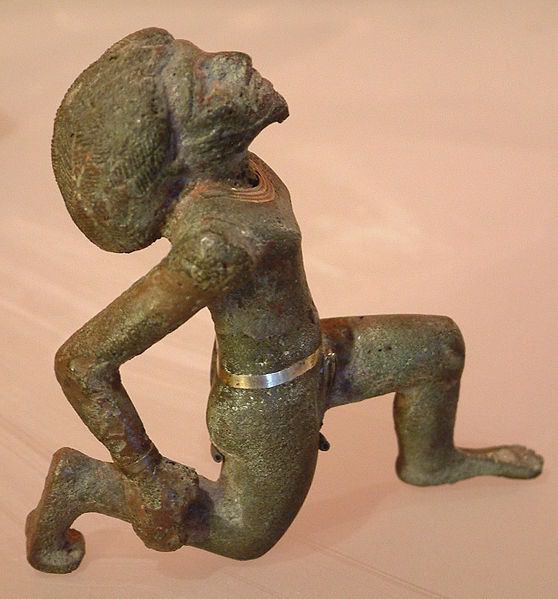
Libyan Figure Statue
It seems it was Hasan, then, who after reforming his army following Kahina's victory returned to meet her a final time. He was now facing a very different opponent than the one who had driven him from North Africa, however. Many of Kahina's former allies had gone over to Hasan whether due to the scorched-earth tactics which demoralized them or bribery. One of Kahina's sons either defected or was captured and is said to have informed on his mother's battle plans.
In either 702 or 705 CE Kahina met Hasan in battle. Before the armies engaged, she is said to have sent her two other sons to the enemy camp to be raised by Hasan as Muslim warriors. The battle went against Kahina from the beginning as she was badly outnumbered but her army fought valiantly and won the admiration of the enemy.
Accounts vary concerning her death; she may have been captured and later executed or may have poisoned herself, but the most commonly accepted account is that she died in battle with her troops, still clutching her sword. Her head was then cut off and brought to Hasan as a trophy.
By all accounts, Hasan respected Kahina as an opponent and her sons, who converted to Islam, were well cared for and would later lead their own armies against others who resisted Arab aggression. Kahina's people, on the other hand, did not fare so well as 30,000 – 60,000 of them were sold into slavery by the conquerors and shipped out of their native land. Small pockets of resistance still held out - and many of the wives of Numidian chiefs are said to have killed themselves rather than be taken by the Arabs - but between c. 705-750 CE North Africa was fully conquered and the people converted to Islam.
CONCLUSION
Kahina herself would live on through the works of Arab historians, most notably the great Ibn Khaldun (1332-1406 CE), working from earlier sources. Her reputation as a “Jewish Sorceress” comes primarily from Ibn Khaldun. She remained an obscure figure until she was seized upon by the French in the 19th century CE to support their military initiative in Algeria: a freedom fighter battling Arab aggression. At that same time, the Imazighen reasserted their claim to her as their heroine while Arab Nationalists in the region somehow managed to argue she was theirs.
Professor Cynthia Becker of Boston University comments:
Since the ninth century, accounts of [Kahina] have been adopted, transformed, and rewritten by various social and political groups in order to advance such diverse causes as Arab nationalism, Berber ethnic rights, Zionism, and feminism. Throughout history, Arabs, Berbers, Muslims, Jews, and French colonial writers, from the medieval historian Ibn Khaldūn to the modern Algerian writer Kateb Yacine, rewrote the legend of the Kahina, and, in the process, voiced their own vision of North Africa's history. (1)
In 2001 CE a statue of Kahina was raised in the Parc de Bercy, Paris as one of a number in an exhibit called “Children of the World” (Les Enfants du Monde). The exhibit celebrates world diversity and the unity of the human experience and the statue was designed by artist Rachid Khimoune to represent Algeria. In Algeria itself, a statue was erected in 2003 CE, possibly in response to the Parisian work, in the town of Baghai, Khenchela Province, honoring Kahina. As her name becomes more widely known, Dihya al-Kahina of the Imazighen inspires not only her own people but those everywhere who honor her memory and sacrifice for the cause of freedom.
Egyptian Obelisk › Antique Origins
Definition and Origins
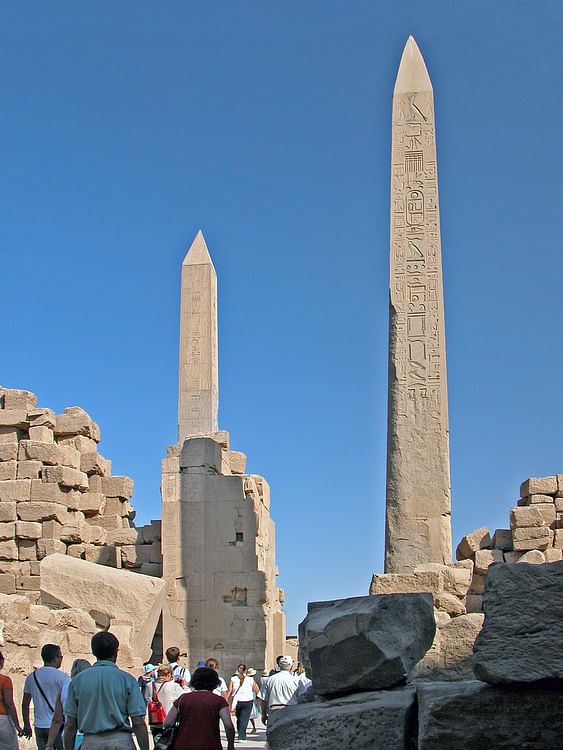
An obelisk is a stone rectangular pillar with a tapered top forming a pyramidion, set on a base, erected to commemorate an individual or event and honor the gods. The ancient Egyptians created the form at some point in the Early Dynastic Period (c. 3150-c. 2613 BCE) following their work in mud brick mastaba tombs and prior to the construction of the Step Pyramid of Djoser (c. 2670 BCE). It is thought that the earliest obelisks served as a kind of training for working in stone on monumental projects which was a necessary step toward pyramid building.
The name "obelisk" is Greek for "spit", as in a long pointed piece of wood generally used for cooking, because the Greek historian Herodotus was the first to write about them and so named them. The Egyptians called them tekhenu which means "to pierce" as in "to pierce the sky". The earliest obelisks no longer exist and are only known through later inscriptions but appear to have been only about ten feet (3 metres) tall. In time they would reach heights of over 100 feet (30 metres).Although many cultures around the world from the Assyrian to the Mesoamerican employed the obelisk form, only ancient Egypt worked in monolithic stone, almost always red granite. Each ancient Egyptian obelisk was carved from a single piece of stone which was then moved to its location and raised onto a base. While archaeologists and scholars understand how these monuments were carved and transported, no one knows how they were raised; modern day efforts to replicate the raising of an obelisk, using ancient Egyptian technology, have failed.
SYMBOLISM OF THE OBELISK
The obelisks of ancient Egypt represented the benben, the primordial mound upon which the god Atum stood at the creation of the world. As such, they were associated with the benu bird, the Egyptian precursor to the Greek phoenix. According to some Egyptian myths the benu bird was the first living creature whose cry awoke creation and set life in motion. The bird was linked to the morning star and the renewal of each day but was also the sign of the end of the world; in the same way the bird had cried to begin the creative cycle, she would sound again to signal its completion.
THE OBELISKS OF ANCIENT EGYPT REPRESENTED THE BENBEN, THE PRIMORDIAL MOUND UPON WHICH THE GOD ATUM STOOD AT THE CREATION OF THE WORLD.
The Egyptians believed a day would come when the gods would die and all would return to the uniformity of primordial chaos.The benu bird would not choose this end of its own but would be given its cue by the sun god Ra who, in turn, would have been informed by the god Thoth, keeper of the records of humans and gods. The benu bird was primarily linked, however, with Ra (later Amun and Amun-Ra) and with light and life. Egyptologist Geraldine Pinch comments on this:
From the Pyramid Texts onward, the benu bird was closely associated with the creator sun god. In Heliopolis, the center of solar worship, the benu bird was said to perch on the benben stone, a kind of primitive obelisk, or in the branches of a sacred willow tree. When Egyptian kings had reigned for thirty years, they asked the benu bird to renew their strength and vitality (117).
While keeping its association with the benu bird, the obelisk came to be increasingly associated with Ra and solar worship, especially from the New Kingdom (c. 1570-1069 BCE) onwards. Obelisks were always raised in pairs in keeping with the Egyptian value of balance and harmony; it was believed that the two on earth were reflected by two in the heavens.Egyptologist Richard H. Wilkinson writes:
The phenomenon of duality pervades Egyptian culture and is at the heart of the Egyptian concept of the universe itself. But rather than focusing on the essential differences between the two parts of a given pair, Egyptian thought may stress their complementary nature as a way of expressing the essential unity of existence through the alignment and harmonization of opposites - just as we today might use "men and women", "old and young", or "great and small" to mean "all" or "everyone" (129).
The dual obelisks were raised in honor of a great king's accomplishments (or, in the case of Hatshepsut, a great queen), but also served to honor the gods or, more often, a specific god. In the period of the New Kingdom the obelisk was thought to be inhabited by the spirit of the god it was raised for in the same way a god was thought to actually live in his or her temple.Thutmose III (1458-1425 BCE) of the New Kingdom instituted the ritual of offering ceremonies to obelisks in the same way that offerings were brought to temples and this practice continued through the Ptolemaic Period (323-30 BCE), the last to rule Egypt before it was annexed by Rome. The pharaohs of the New Kingdom erected more obelisks than any other in the belief that they would live on through these monuments as offerings would continue to be brought to them after their death.
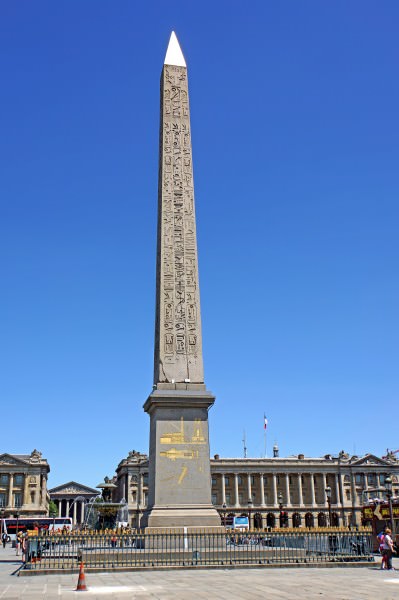
Luxor Obelisk, Paris
The obelisks, then, represented the living deity, the vitality and immortality of the pharaoh, and the concept of duality and balance. No matter who or what else they commemorated, though, they were raised and carefully positioned so that the first and last light of day would touch their peaks to honor the sun god. The sun god was thought to enter on a perilous journey at night where he would have to navigate his barge through the underworld and avoid destruction by the great serpent Apophis.The Egyptians performed ceremonies to ward off and weaken Apophis and keep the sun god safe and, in this way, they took part in the cycle of day and night. Obelisks served to honor the sun god as he rose from night in the morning, crossed the sky, and disappeared back into darkness at evening. On a practical level, the obelisk would have then served as a sun dial in that the journey of Ra across the sky would have been indicated by the movement of the shadow of the monument except when the sun was directly overhead and no shadow would be cast.
CONSTRUCTION & PLACEMENT
The largest obelisk ever created was never raised: the so-called "unfinished obelisk" of the pharaoh Hatshepsut (1479-1458 BCE) which still rests where it was abandoned at the quarry of Aswan, the site regularly used for quarrying stone for such monuments. The unfinished obelisk is thought to have been commissioned for placement at Karnak, where Hatshepsut had already raised the monument known today as the Lateran Obelisk which was moved to Rome in the 4th century CE by Constantius II. The unfinished obelisk measures 137 feet (42 metres) and is approximated to weigh 1,200 tons. Work on the monument was abandoned when it cracked while being carved and so it remains, in situ, just as it was left thousands of years ago when the workers walked away from it. Marks from ancient tools and worker's measurement-markings are clearly visible on the piece and provide insight into how obelisks were quarried.
Workers began carving an obelisk out of the granite bedrock at Aswan using chisels and wooden wedges. Egyptologist Rosalie David explains:
Evidence at Aswan indicates that to remove the stone the masons probably chiseled holes into the rock to a depth of about six inches and then forced wooden wedges into these holes before moistening them with water so that the wood swelled and caused the rock to split. The obelisk could then be chiseled out and transported by river to the site of the temple, where it was finished (171-172).
The tools used were metal, such as copper, and stone. Volcanic rock (Diorite) was also used to loosen the stone once holes had been made. David takes note of Flinders Petrie's discoveries that "metalsmiths were adept at judiciously adding certain alloys to metals to make them suitable for particular tasks; they also tempered them and thus were probably able to produce tools of required strength to deal with all those stones" (172). It is unknown exactly how long it took workers to quarry and shape an obelisk but the entire process, from initial quarrying to transport to raising of the monument, took approximately seven months. Historian Margaret Bunson describes the process of moving an obelisk from the quarry at Aswan to its destination at Thebes :
When the pillar was carved to satisfaction, ropes were slung around it and the stone was raised and placed on a heavy sledge. It took several thousand workmen to pull the sledge to the banks of the Nile. There, vessels waited in dry docks specially designed to allow safe loading of the pillars. The unique aspect of this loading process is that the boats remained in dry dock until the pillars were safely on board. Then the vessel and the sacred cargo were slowly floated on water emptied into the dock. When the ship and the pillar were stabilized, the dock gates were opened and the vessel made its way out onto the Nile. Nine galleys, each with more than 30 rowers, towed the vessel and the obelisk to Thebes where a ceremonial ritual and vast crowds awaited their arrival. A ramp was prepared in advance and the pillar was pulled to the incline. The unique part of the ramp was a funnel shaped hole, filled with sand. The obelisk was positioned over the hole and the sand was emptied, thus lowering the pillar into place. When the obelisk had been positioned on its base and fastened there, the ramp was removed and the priests and royal household arrived to take part in dedication rituals and in ceremonies in honor of the god of the stone (194-195).
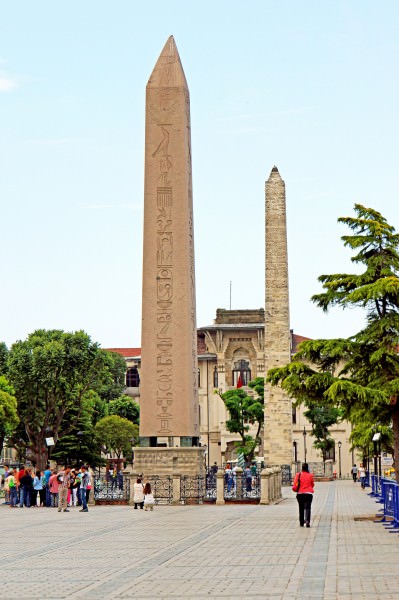
Obelisk of Thutmose III, Istanbul
The quarrying, transport, and raising of an obelisk is well documented through inscriptions, drawings, and official letters on the subject but no specific mention is made of how exactly the obelisk was raised to position on its base. Bunson's description of the funnel-shaped hole draws on ancient Egyptian sources which would seem to indicate that the base of the obelisk was beneath the ramp and covered with sand. The bottom of the obelisk would be positioned over this hole and sand removed slowly to raise the monument while, presumbably, workmen with ropes carefully guided the obelisk as it rose.
The ancient Egyptian inscriptions on this part of the process are unclear, however, and the problem with assuming the funnel-shaped hole in the ramp clarifies anything is that this hole would have to have been of considerable depth to aid in raising a 100 foot tall monument, there would have to have been some kind of groove to prevent slippage on the base, and workers would have needed to find some way to pull the obelisk upright once it had attained a certain height and angle; modern attempts to replicate this process have failed. In 1995 CE a NOVA team with archaeologist Mark Lehner attempted to raise an obelisk based on the Egyptian sources and failed. When they used more modern techniques they failed as well. The funnel-shaped hole of sand would only have had to be deep enough to bring the edge of the bottom of the obelisk down to the edge of a groove in the base but this did not work. Further, the angle of the obelisk as it was rising stopped at 40 degrees and the modern-day workers with their ropes could find no way to raise it further.
In 2001 CE, abandoning the ancient sources, aeronautics professor Mory Gharib and a team raised a 6,900 pound obelisk using kites, a pulley system, and a support frame. Harnessing wind power and calculating leverage needed for the pulley system carefully, the obelisk was raised in 25 seconds. Gharib claims that this was most likely how the ancient obelisks were raised as well as how the pyramids and temples of Egypt were built. This claim, however, is entirely speculative as there are no records indicating a use of kites in construction in ancient Egypt.
Bunson's description, although specifically citing Thebes, would have applied to any of the sites where obelisks were found.Although they were primarily raised at Karnak they were also positioned outside of many temples from Heliopolis (near modern Cairo) in Lower Egypt to Elephantine in Upper Egypt near Aswan.

Obelisk of Senusret I, Heliopolis
OBELISKS & TEMPLES
Obelisks were frequently positioned in the courtyards of temples to honor the god within as well as the sun god who would sail overhead. The only obelisk still standing in its original position is that of Senusret I (c. 1971-1926 BCE) at the site of a former temple to the sun god at Heliopolis. Other obelisks were removed by foreign nations or given as gifts to countries by the Egyptian government in the modern era. Inscriptions and documentation, however, make clear that obelisks were a regular feature of temples throughout ancient Egypt. Wilkinson states:
Symbolic orientation and placement can perhaps be most easily seen in the Egyptian temple, where it was employed constantly at both the macro and micro levels. Many temples were located on sacred sites or built close enough to the Nile to be partially submerged during the river's annual flooding, thus symbolic of the watery creation of the world. Certain late temples also had shrines built on their roofs and crypts below ground level, probably symbols of heaven and the underworld. Most temples were aligned, at least theoretically, with the daily passage of the sun. This alignment is seen in the positioning of the horizon-like pylons, towering obelisks, and solar disks painted along the architraves of the temple's east-west axis (66).
These obelisks would have been carefully measured and cut to conform to the size of a particular temple and the position they would take up there. The point of the pyramidion top of the obelisk was supposed to catch the first and last sun's rays and so the monument had to be high enough and positioned in such a way to accomplish that. The location of the obelisk and its height was the responsibility of the king who would commission both the temple and the complex surrounding it. Wilkinson writes:
From the very foundation of a temple, the king played the dominant role in its construction and functioning. Individual monarchs were responsible for building the successive pylons and courts added to Egypt's greatest temples and even complete structures in other cases. Representations show the king involved in a foundation ritual known as "stretching the cord" which probably took place before work began on the construction of a temple or of any addition. These depictions usually show the king performing the rite with the help of Seshat, the goddess of writing and measurement, a mythical aspect which reinforced the king's central and unique role in the temple construction (174).
Ramsés II (el Grande, 1279-1213 aC) encargó el mayor número de obeliscos para los templos y alentó la práctica continua de presentarles ofrendas. Colocó sus obeliscos en el Templo de Amón en Tebas, en el Alto Egipto, hasta Heliópolis, en el Bajo Egipto, y sin duda tuvo otros en su ciudad de Per-Ramsés, en el sitio de la antigua ciudad de Avaris. Grandes porciones de Per- Ramsés ("la ciudad de Ramsés") fueron desmanteladas para la construcción de Tanis bajo el reinado de Smendes (hacia 1077-1051 aC) después de que el Nilo cambiara de rumbo y dejara la antigua ciudad sin suministro de agua.
A lo largo del Tercer Período Intermedio (hacia 1069-525 aC), Tanis fue una ciudad importante diseñada para reflejar a Tebas, mucho más antigua, y aunque es posible que se hayan creado obeliscos para la ciudad, es más probable que sean trasladados de la ciudad de Ramsés. Como en todos los aspectos de la construcción y el posicionamiento de los obeliscos, la cantidad de esfuerzo para lograr esto habría sido considerable, pero al parecer, para los egipcios, los monumentos que perforaron el cielo y honraron a los dioses valieron la pena. El resto del mundo parece estar de acuerdo ya que los obeliscos egipcios, o las imitaciones de la forma, se pueden ver prominentemente exhibidos en muchas ciudades modernas en la actualidad.
LICENSE:
Article based on information obtained from these sources:with permission from the Website Ancient History Encyclopedia
Content is available under License Creative Commons: Attribution-NonCommercial-ShareAlike 3.0 Unported. CC-BY-NC-SA License